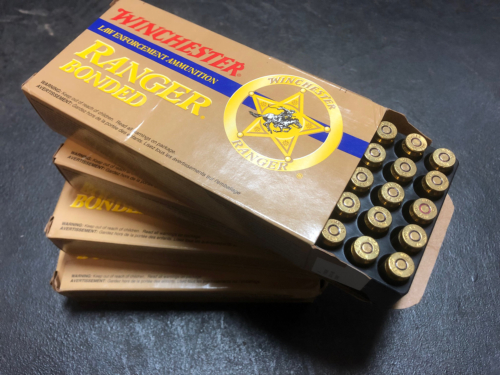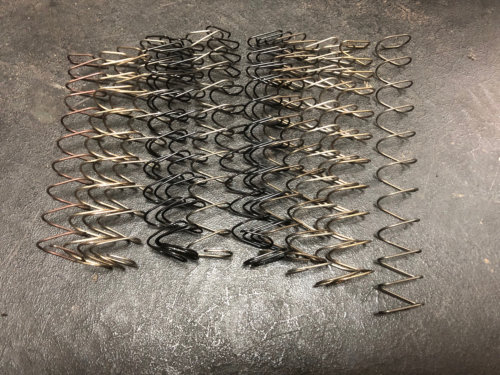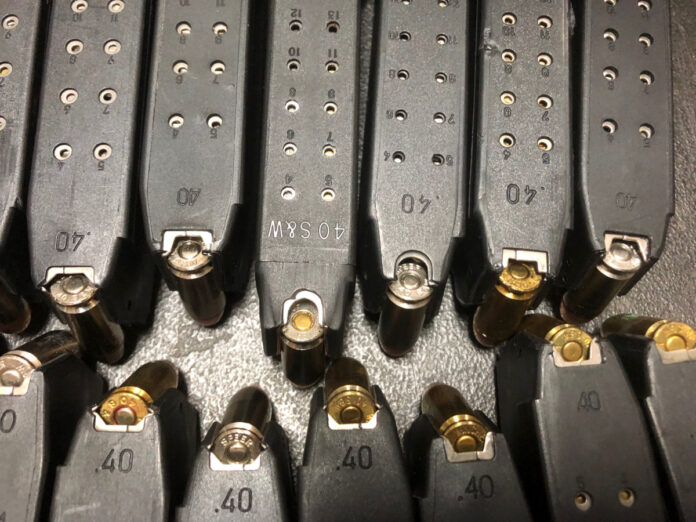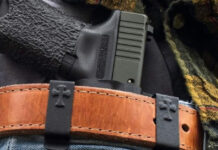Since I’m stuck at home due to the coronavirus, I decided to clean and recondition all my Glock magazines. After all, I’ve owned a Glock 22 since 1993, used them in USPSA competitions in the 1990s and into the 2000s, and carried a Glock 23 for decades, so some of my magazines are pretty old. Maybe those 25-year-old springs could use a replacement.
After some online searching, I found Wilson Combat music wire springs for the low, low price of $1.60 each, a shockingly good price, especially compared to springs I had purchased previously
I didn’t know how many springs I would need. I did some quick calculating in my head and decided I probably had 12 loaded magazines. But at $1.60, why play it safe. I bought 24 springs.
I also bought ordered 200 rounds of Winchester Ranger SXT ammo in .40. My plan was not only to replace all the springs, but to reload the magazines with fresh, new ammo. Ranger SXT is highly rated on the FBI tests for its penetration, expansion and performance against various barriers. I like 155 grain due to its speed, but settled on 165 grain because that is what they had, thereby splitting the difference between my 180 gain reloads I practice with and the faster 155 grain stuff I normally carry.

I also bought ordered 200 rounds of Winchester Ranger SXT ammo in .40. My
The Great Magazine Search
Once the mail order supplies came in, I looked everywhere for magazines and discovered 19 loaded Glock 22 magazines in and around my house plus a few unloaded and unloaded. 16 were actual Glock brand magazines, five were Korean magazines and one was an old Scherer mag. I also had a few Glock 23 magazines that probably came with the gun.
The mags were loaded with a variety of ammo: 155 grain HydroShok, 155 grain Gold Dot, and a few other brands of jacketed hollow points in both 155 and 180 grains. The practice mags were loaded with 180 grain flat nose TMJs from Montana Gold that I have reloaded over the years. One magazine even had six rounds of old Glaser safety slugs at the top of the mag. Wow, those must be old! I think Corbon bought them out some years ago.
That ammo went into boxes clearly labeled “Practice Rounds” and will be shot up over the next couple of trips to the range. Why make it practice ammo? Because it has been in hot cars and cold garages, carried on my person where it was subjected to body oils and being jostled about, or simply stored for years. Why risk your life on old ammo when new ammo is about $100 for 200 rounds?
How to Recondition your Magazines
Because I want to reassemble each magazine with the same floor plate and follower it originally had, I unloaded, disassembled, cleaned, replaced the spring and reassembled each magazine, one at a time. As you can imagine, with that kind of repetition, I became quite efficient at getting the floor plate off.
To clean each magazine, I hammed a rag t-shirt into the body of the magazine with a long screw driver and wiggled it around as much as possible, including poking a portion up through the feed lips. If the T-shirt came out dirty, I would spray the magazine with gun cleaner (choose a brand that says it will not harm plastic), let it soak a minute or two, scrub it with an old toothbrush, and repeat the t-shirt cleaning at least twice more. Like cleaning a barrel, you only stop when the shirt stays white.

After cleaning, it was time to consider whether or not the magazine needed a new spring. To do this, I compared the length of each spring with a news spring. Springs that were very close to the new ones went back into their magazine. Any springs that were significantly shorter were replaced. I tossed the worst of the old springs and put half a dozen of the not-so-bad used springs in my repair kit for a just-in-case moment.
Before reassembly, I carefully inspected each clean magazine for damage and wear. Just to be on the safe side, I replaced a couple followers and floor plates. I know there were several years when I fired more than 10,000 rounds in competition and practice, and when you shoot to slide lock, it can chew up the follower. This maintenance probably should have been done a decade ago, but at least it’s been done now.
Note that I’m cleaning Clock Magazines, but the instructions should be the same for just about any magazine with a removable floor plate. So if you shoot a Smith & Wesson, a Sig Sauer, Springfield, Ruger, or another modern pistol, you should be fine.
Reasonable vs Paranoid
It quickly became clear that my 200 rounds of new ammo was about 100 rounds short if I planned to replenish all the magazines. I had about 300 loaded rounds in magazines stashed all around, but I only had 200 new bullets.
After some consideration, I decided that having 300 rounds of .40 ammo loaded in Glock 22 magazines ready to rock and roll was probably closer to paranoid than reasonable. I could not think of a single likely self-defense scenario in which my wife and I would each grab a Glock and fire more than 7 magazines each, especially considering that we also have a loaded 12 gauge and an AR or two available.
After giving the matter some more though, I concluded that if and when we find ourselves in a world without the rule of law, carrying five or more loaded magazines will probably make damn good sense. But I’m not John Wick; I’m a “gray man” who keeps to himself, doesn’t hang out in bars or bad neighborhoods, isn’t out and about late at night, doesn’t deal in drugs or with criminals, and spends his nights protected by fences, locks, and large dogs. So for me and mine, that time hasn’t yet arrived where I feel the need to load up with more than two reloads and pocket pistol as a backup. With any luck, all my firearm preps will be for nothing and my heirs will get to shoot up all my carefully hoarded ammo and sell my extra gear on Gun Broker.
So now I only have 10 loaded magazines, and I don’t feel any less safe than I did before.
Don’t get me wrong: I am fully in favor of owning spare magazines – the more the merrier. Magazines can and do break. Floor pates pop off, dumping your rounds on the ground. Followers crack and I’ve seen (although never on a Glock) the spring push up between the feed lips and jam the gun. Mag bodies get stepped on or run over. Magazines are easily lost if you are in a dynamic, rapidly moving fire fight. They may also be confiscated by law enforcement. You need to extras, both on you and in a secure location for resupply.
Final Words: Clean and PM Your Guns & Gear
When I worked with a city police department, officers had to turn their issued gun in to the armorer once a year for PM (preventative maintenance). The armorer had a nice ultrasonic tank for cleaning, and he would check all the springs, make sure the extractor isn’t chipped, and that the safeties functions correctly. Should you do any less?
If you carry a gun to protect yourself and your family, take some time in the next week or two to clean and maintain it, and do the same with your carry mags. Don’t just hose them off with a spray can, but actually disassemble them and clean and inspect every part. Lint, flakes or dried skin, and all sorts of mysterious environmental gunk can get in there, often attracted and held in place by your gun lube. Blow the fuzz out of your holster as well, especially if you use a pocket holster or carry inside the pants. I prefer leather, but even Kydex can get dirty. If you are an inexperienced gun owner and don’t know how to maintain your gun, watch a YouTube video.
While you are at it, swap out your carry ammo for some fresh stuff. Then go to the range and shoot the old ammo. It is good practice and you’ll reassure yourself that your gun goes bank instead of click.
This PM is valuable. I’ve spotted rust starting on a rear sight, found mold growing on leather slings, and realized I needed to replace batteries on gun-mounted flashlights. And yes, I’ve found lots of lint in pocket holsters.
You wouldn’t leave your car in the garage for a year without checking on it; give your gun the same courtesy so it doesn’t become a rusty old “garage find” one day.
If you enjoyed this article, you might like A Surprising Answer to the Question: What’s the Best Survival Gun or one of the other articles in our prepping category.








